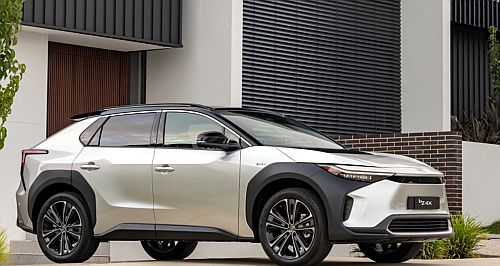Make / Model Search
News - Toyota - BZ4XToyota wants delay, big changes to NVESAdjustments, delay to New Vehicle Efficiency Standard in Toyota Australia crosshairs4 Mar 2024 TOYOTA Australia has once again defended its stance on the federal government’s New Vehicle Emissions Standard (NVES) at the launch of its first all-electric car, the bZ4X, with the company outlining its hopes for a delay and changes to the proposed scheme.
Joining a range of petrol-electric hybrid vehicles – Yaris, Yaris Cross, Corolla, Corolla Cross, C-HR, RAV4, Kluger, Camry and Tundra pick-up – the new bZ4X becomes part of Australia’s most-electrified model range.
Despite the hybrid-heavy line-up, Toyota could still be severely penalised for some of its other models under the Albanese government’s preferred NVES settings.
The classifications outlined in the NVES draft paper includes the determination that larger SUVs be considered passenger cars, which according to Toyota would force it to pass on any applicable fines for the likes of the Fortuner and LandCruiser range (Prado, 70 Series and 300 Series).
An earlier GoAuto report pointed out Toyota’s displeasure about some elements of the NVES, but there was more to add, according to Toyota Australia vice president of sales and marketing Sean Hanley, who flagged the potential to have to axe some of the brand’s popular models, or raise prices significantly.
Mr Hanley confirmed that the brand will call for compromises when it comes to the classification of vehicles, not to mention a rethink of the timeline for the implementation of any new classifications.
“It’s less than 11 months away,” said Mr Hanley of the proposed roll-out for the in-practice NVES.
“I want the myths and mistruths to stop. Toyota welcomes the policy certainty of an ambitious fuel efficiency standard,” he said, before adding: “The proposed transition that we're seeing right now – the timing of that transition is too quick.
“The trajectory is too steep, especially for large four-wheel-drive SUVs and light commercial vehicles. It simply doesn't recognise the technical hurdles, the length of time and the substantial costs that will be required to deliver the commercial BEVs that are practical, that are capable, and above all, are affordable.
“In short, unless the final scheme is less aggressive, it will have a profound negative impact on regional and rural Australia and that will reverberate throughout the Australian economy,” Mr Hanley warned.
Mr Hanley pointed out that it was not as simple as asking for an electric version of a LandCruiser and getting it in time for any implemented standards.
“I can’t get a ZEV (zero-emissions vehicle) LandCruiser in 11 months’ time,” he said, pointing out that the categorisation of larger SUVs under NVES is something he hopes may be reconsidered, lest the brand be penalised with fines for its higher-polluting larger vehicles that will potentially be categorised as passenger cars.
Proposals in the scheme point to a brand being required to either add battery electric vehicles (BEV) to lower its fleet CO2 footprint which, as Mr Hanley points out, is not as easy as flicking a switch.
Otherwise, those companies could potentially buy offset credits from other brands, or pass the fines that will be imposed by the government on to their customers, in essence seeing new-car prices for certain models – utes and SUVs, in particular – attracting potentially hefty price increases.
“Our going-in position right now is we would need to pay the fines and ultimately a good proportion of that – if not all of that – would need to be passed on to consumers,” he said, adding that purchasing offset credits from the likes of Tesla and BYD was off the table.
“We have a philosophical problem buying credits off something we don’t have an ownership stake in,” Mr Hanley asserted.
Another option on the table is a Super Credits scheme, where additional BEVs could potentially act as a multiplied reward to assist in covering the cost of selling CO2-emitting vehicles.
“These are things we need to consider,” Mr Hanley said of joining other brands that are in support of a Super Credits scheme, including Hyundai.
“Importantly, Toyota isn't limited to any single electrification solution. We are a full line-up manufacturer of vehicles that can help everyone reduce their carbon footprint in all parts of the world,” he said.
“This includes hybrid-electric, plug-in hybrid electric vehicles, fuel-cell electric and battery-electric vehicles.
“You've also seen the investment we're making in other technologies such as hydrogen injection and carbon-neutral fuels. There's more than one way to go on this decarbonisation journey. This is truly our multi-pathway approach. It's designed to help motorists as they understand and engage with the BEVs and decarbonisation, and the launch of the bZ4X greatly strengthens our strategy.”
The Toyota bZ4X has arrived as the brand’s first fully electric model, with two variants comprising the entry-grade $66,000 (before on-road costs) front-wheel drive version offering a 436km WLTP range, and the higher-grade, all-wheel drive option for $74,900 + ORC with 411km WLTP range.  Read more |
Click to shareToyota articlesResearch Toyota Motor industry news |












Facebook Twitter Instagram